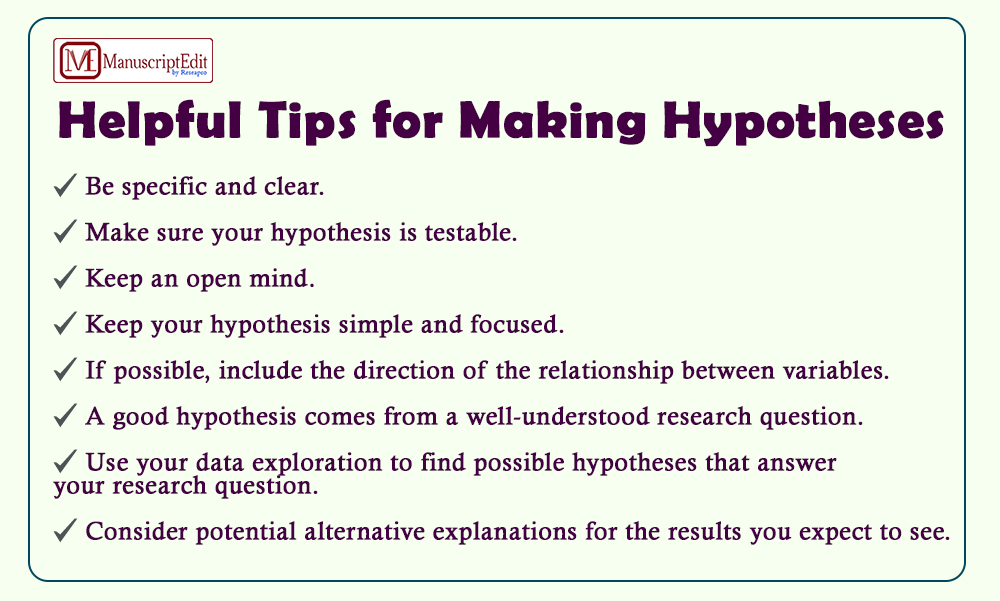 This study explores the complexities of developing compelling ideas by exposing the heart of scientific investigation. Learn how to formulate hypotheses effectively to reveal the mysteries of research.
This study explores the complexities of developing compelling ideas by exposing the heart of scientific investigation. Learn how to formulate hypotheses effectively to reveal the mysteries of research.
How do Hypotheses Drive the Scientific Method?
The scientific method relies heavily on hypotheses because they offer verifiable explanations for occurrences that are seen. Based on what is already known, scientists create hypotheses and utilize them to forecast future events.

These ideas are tested by methodical experimentation and observation, which enables researchers to determine whether or not to accept the original theories—the process of iteration aids in advancing and improving scientific knowledge.
Characteristics of a Strong Hypotheses
Formulating a hypothesis is analogous to erecting a sturdy base for scientific investigation. It entails taking into account a few crucial factors:
- Clarity: Ensure that your hypothesis is very apparent. To ensure that everyone understands the results accurately, it should clarify the predicted link between objects in straightforward terms.
- Testability: An adequate hypothesis can be verified by experiments or by observation. You should gather information that validates or refutes your hypothesis. Your theory is nothing more than a hazy concept without this.
- Falsifiability: It is possible to refute scientific theories. This promotes knowledge acquisition and critical thinking. We can learn more about the world by testing hypotheses and rejecting them.
Including these components strengthens your hypothesis and provides the foundation for significant study that yields new findings and a more comprehensive understanding of the world.

Steps in Crafting an Effective Hypothesis
Developing a solid hypothesis requires a few essential steps.
- Define the Research Question: Clearly state the issue or query your study seeks to answer in your research question definition.
- Perform Background Research: Examine the body of literature already in existence to comprehend the situation and pinpoint knowledge gaps.
- Formulate a Research Hypothesis: Create a precise, verifiable statement that forecasts the link between the variables in your research hypothesis.
- Define Variables: Make sure the independent and dependent variables are measurable and manipulable by providing explicit definitions.
- Check Falsifiability: Make sure the hypothesis is falsifiable by designing it to be empirically tested and falsified through data analysis.
- Employ Clear terminology: Don’t use jargon or unduly sophisticated terminology when expressing the hypothesis; use plain, unambiguous language.
- Quantifiable Predictions: To enable objective measurement, ensure the hypothesis contains precise predictions regarding the anticipated outcomes.
- Take into Account Scope and Feasibility: Assess the feasibility and extent of testing the hypothesis in light of time, resource, and ethical restrictions.
- Examine and Improve: Get input from mentors or peers and make necessary adjustments to the hypothesis in light of helpful critique.
- Compose a Clear Hypothesis Statement: In a brief sentence, represent the research question and the anticipated relationship between the variables in your hypothesis.

Testing and Refining Hypotheses
Creating experiments to collect information and evaluate the accuracy of predictions is the process of testing hypotheses. A thorough examination of the data refines or disproves theories. Reliability is improved by iterative testing, variable adjustment, and confounding factor management.
To guide judgments, statistical approaches evaluate significance. Iterative improvement guarantees precise models, promoting advancements in science.
Conclusion
Crafting a hypothesis with skill is like playing the conductor in a symphony of scientific discovery, leading research toward a more profound understanding. Accept the art since theories drive inquiry into unknown territories.
